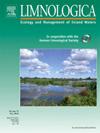Short-term and seasonal dynamics of planktonic protist community (Alveolata, Ciliophora) in a neotropical urban lake, Maringá - Paraná, Brazil
IF 2
4区 环境科学与生态学
Q2 LIMNOLOGY
引用次数: 0
Abstract
The aim of this study was to investigate the temporal dynamics of planktonic ciliate communities, based on daily fluctuations between different hydrological periods in a eutrophic urban lake located in the city of Maringá, Paraná, Brazil. We hypothesized that abundance would vary more between collection days than between hydrological periods, whereas richness and selection would vary more between hydrological periods than collection days. Ciliated protists were sampled during two distinct hydrological periods: a dry period in September 2018 and a rainy period in January 2019. Sampling was conducted 10 times during each period, with collections every 3 days over 30 days. Throughout the study, 84 morphospecies were recorded. The Prostomatida group dominated in both periods, contributing to 37.1 % of the total abundance in the dry season and 74 % in the rainy season. Other representative groups included Peritrichia (35.7 % in the dry season) and less abundant taxa such as Nassulida, Colpodea, and Cyrtophorida (8.5 % in the rainy season). Abundance varied significantly in the short term (i.e. between sampling days) and between hydrological periods (dry and rainy), with higher values during the rainy season (mean ± SE: 1250 ± 150 Ind.L⁻¹) compared to the dry season (mean ± SE: 850 ± 120 Ind.L⁻¹). Differences in richness were not significant between the hydrological periods. However, there was significant daily variation during the rainy season. Species composition differed only between hydrological periods, as predicted. This study shows that the hydrological regime significantly influences ciliate communities, with variations in richness, abundance, and composition occurring over short periods. Therefore, it is recommended that these organisms be analyzed continuously, across short intervals, and seasonally. This approach is necessary because their responses to environmental monitoring may vary depending on the sampling period, given their high sensitivity to environmental changes.
巴西maring - paran新热带城市湖泊浮游原生生物群落(Alveolata, Ciliophora)的短期和季节动态
本研究的目的是基于位于巴西帕拉paraning市的一个富营养化城市湖泊不同水文期之间的日波动,研究浮游纤毛虫群落的时间动态。我们假设丰度在不同的采集日之间比在不同的水文时期之间变化更大,而丰富度和选择在不同的水文时期之间比在不同的采集日之间变化更大。在两个不同的水文时期对纤毛原生生物进行了采样:2018年9月的干旱期和2019年1月的雨季。每期抽样10次,30天内每3天采集一次。在整个研究过程中,记录了84种形态种。Prostomatida类群在两个时期均占主导地位,在旱季占总丰度的37.1% %,在雨季占74 %。其他代表性类群包括Peritrichia(旱季为35.7 %)和较少的分类群如Nassulida、Colpodea和Cyrtophorida(雨季为8.5 %)。丰度在短期内(即采样日之间)和不同水文时期(旱季和雨季)变化很大,雨季的丰度(平均± SE: 1250 ± 150 Ind.L⁻¹)比旱季的高(平均± SE: 850 ± 120 Ind.L⁻¹)。不同水文期间丰富度差异不显著。然而,在雨季有显著的日变化。正如预测的那样,物种组成只在不同的水文时期有所不同。该研究表明,水文制度显著影响纤毛虫群落,其丰富度、丰度和组成在短时间内发生变化。因此,建议对这些生物进行连续的、短时间间隔的季节性分析。这种方法是必要的,因为它们对环境监测的反应可能因采样周期而异,因为它们对环境变化高度敏感。
本文章由计算机程序翻译,如有差异,请以英文原文为准。
求助全文
约1分钟内获得全文
求助全文
来源期刊

Limnologica
环境科学-湖沼学
CiteScore
3.70
自引率
5.90%
发文量
64
审稿时长
3 months
期刊介绍:
Limnologica is a primary journal for limnologists, aquatic ecologists, freshwater biologists, restoration ecologists and ecotoxicologists working with freshwater habitats.
 求助内容:
求助内容: 应助结果提醒方式:
应助结果提醒方式:


